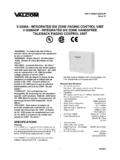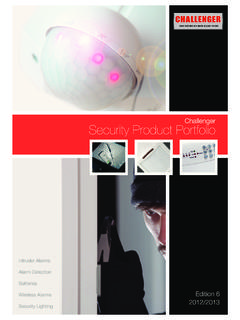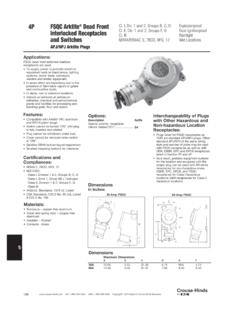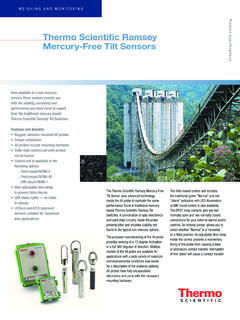Transcription of TECHNICAL BULLETIN 226 - SNIPEF
1 TECHNICAL BULLETIN 226 Page 1 of 4 CORGI has used its best efforts in the production of this information, but makes no warranty about the content and will not be held liable under any circumstances for any direct or indirect damages resulting from the use of this information. This document may not be reproduced in whole or in part without the consent of CORGI other than for personal reference purposes only. This document is uncontrolled when printed, please see for controlled (current) copy.
2 TECHNICAL BULLETIN 226 Date issued: 16th May 2008 Author: David Smith Status: Current Reviewer: May 2009 Title: Electrical safety requirements for gas appliances installed in rooms or spaces containing baths or showers This TECHNICAL BULLETIN supersedes TB 180 which is now withdrawn British Standard (BS) 7671: 2008 Requirements for Electrical Installations - IEE Wiring Regulations Seventeenth Edition) has recently been amended and is effective from the 1st July 2008. Any electrical installation designed and installed after this date should comply with this edition of the standard.
3 This will include the electrical installation of a gas appliance that is installed in any room or space containing a bath or shower. The electrical requirements for the installation of gas appliances in rooms containing a bath or shower are not new; however there are some important changes in BS 7671: 2008 in section 701. (Section 601 of BS 7671: 2001). Gas appliances should only be installed in a room or space containing a bath or shower if there is no other practical location. If there is no alternative to installing a gas appliance in a this location, and in addition it can only be located in one of the zones identified in Figure 1 (below), then it needs to be suitably rated for use in that particular zone.
4 Any controls for the appliance need to be adequately IP (International Protection) rated for use in the appropriate zone. Information on the zone requirements is contained in Zones in locations containing a bath or shower below. BS 7671: 2008 Section 701 - Locations containing a bath or shower Regulation of BS 7671: 2008 requires that all circuits within this location shall be provided with additional protection by a residual current device (RCD) not exceeding 30mA, with an operating time not exceeding 40ms at a residual current of 5 x I n (this would effectively be 150mA).
5 The RCD requirement will include low voltage lighting circuits, shower circuits, bathroom heaters, electric towel rails, central heating boilers, etc and the 230 V supply to Separated Extra Low Voltage (SELV) equipment. Note: I n is the rated residual operating current of the protective device in amperes. Unlike the 2001 edition of BS 7671, a standard 13 amp socket-outlet is now permitted to be installed in a room or space containing a bath or shower as long as it is sited no closer than 3m measured horizontally from the edge of Zone 1 (see Figure 1 below) and is protected by a 30mA RCD.
6 In the 2001 edition of BS 7671, there was a requirement to provide local supplementary equipotential bonding to all metallic water and gas pipes, metallic waste pipes, any metallic central heating pipework, any metallic structures, metallic baths and metallic shower trays, when any electrical equipment was installed within the zones in a room or space containing a bath or shower. However in BS 7671: 2008 this is not required as long as the following criteria are met: TECHNICAL BULLETIN 226 Page 2 of 4 CORGI has used its best efforts in the production of this information, but makes no warranty about the content and will not be held liable under any circumstances for any direct or indirect damages resulting from the use of this information.
7 This document may not be reproduced in whole or in part without the consent of CORGI other than for personal reference purposes only. This document is uncontrolled when printed, please see for controlled (current) copy. All final circuits of the location comply with the automatic disconnection requirements of regulation , that means automatic disconnection of the supply in the case of a fault by providing an over current protective device. All circuits, including lighting circuits will have to be protected by an RCD in accordance with Regulation All extraneous-conductive-parts which would include the main metallic water supply, the gas outlet supply and any other exposed metallic structure will require to be connected to the protective equipotential bonding (previously known as Main Equipotential Bonding)
8 According to Regulation Therefore as long as the gas installation pipework and metallic water installation pipework is bonded to the main protective earthing terminal, there is no requirement to bond the gas appliance and pipework, unless the appliance manufacturer asks for such bonding in the installation instructions. However if these requirements cannot be achieved then supplementary equipotential bonding will have to be provided as specified in Regulation of BS 7671: 2008.
9 This is to bond all metallic pipes including central heating pipework, metallic structures, metallic baths, shower trays etc. Supplementary equipotential bonding may be installed outside or inside rooms or spaces containing a bath or shower, preferably close to the point of entry of extraneous-conductive-parts into such rooms. Zones in Locations containing a bath or shower There is no Zone 3 in BS 7671: 2008 unlike the 2001 edition. Therefore the zones are made up as follows: Zone 0 Zone 1 Zone 2 The diagram below provides details and dimensions of the zones.
10 Figure 1 TECHNICAL BULLETIN 226 Page 3 of 4 CORGI has used its best efforts in the production of this information, but makes no warranty about the content and will not be held liable under any circumstances for any direct or indirect damages resulting from the use of this information. This document may not be reproduced in whole or in part without the consent of CORGI other than for personal reference purposes only. This document is uncontrolled when printed, please see for controlled (current) copy.











